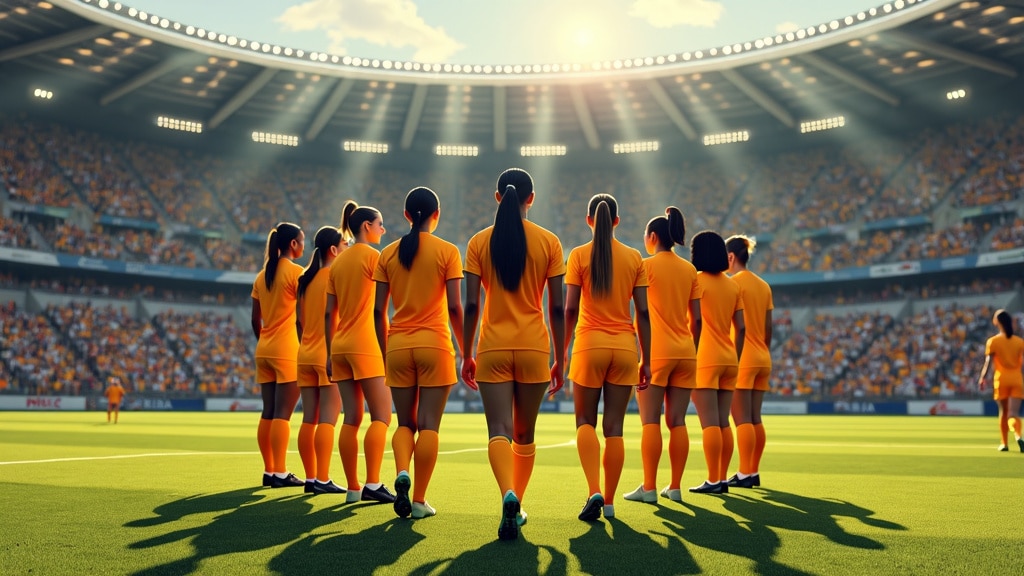Recent Legislation Affecting NIL Rights: Essential Insights for Female Athletes
In recent years, the landscape of college sports has seen significant changes, particularly with the implementation of Name, Image, and Likeness (NIL) legislation. This new era allows college athletes to profit from their personal brand, offering opportunities that were previously unimaginable.
For female athletes, understanding these changes is crucial to maximize their earning potential and gain agency in the sports world.

The NIL laws, approved across various states, have opened doors for all student-athletes to benefit from their fame. Yet, disparities remain, with male athletes reportedly securing a larger share of NIL deals. This disparity highlights the need for female athletes to be informed and proactive in navigating NIL opportunities.
Female athletes must stay abreast of ongoing legal developments and market trends to ensure they leverage their visibility and talents effectively.
By doing so, they can better compete for sponsorship deals and endorsements, and advocate for equitable treatment within the ever-evolving sports industry.
Understanding NIL Legislation
Table of Contents
- 1 Understanding NIL Legislation
- 2 Impact of Recent Legislation on Female Athletes
- 3 Navigating the Legal Landscape
- 4 Role of Coaches and Athletic Administrators
- 5 Parental Guidance and Support
- 6 Advocacy and Awareness
- 7 Case Studies and Examples
- 8 Future Trends and Predictions
- 9 Frequently Asked Questions
- 9.1 What are the new NCAA NIL rules for female athletes in 2024?
- 9.2 How do recent NIL laws impact the earnings of female college athletes?
- 9.3 Which legislation has significantly changed the NIL landscape for student-athletes?
- 9.4 What are the implications of NIL deals on gender equity in college sports?
- 9.5 Can athletic departments directly compensate student-athletes under the latest NIL legislation?
- 9.6 What factors contribute to the negative perceptions of NIL in college sports?

NIL legislation has significantly changed the landscape of college sports, allowing student-athletes to monetize their name, image, and likeness. This guide covers the historical background, key legislative milestones, and the current federal and state laws impacting NIL.
Historical Background of NIL Rights
The concept of NIL rights for student-athletes has been contentious for decades. Historically, the NCAA maintained stringent rules that barred student-athletes from profiting from their name, image, and likeness.
These rules aimed to preserve amateurism in college sports but were increasingly criticized as unfair and restrictive.
The debate gained momentum in the early 2000s, as the financial disparity between the revenue generated by college sports and the lack of compensation for athletes became evident.
During this period, cases such as NCAA v. Alston began to challenge these restrictions, highlighting the need for reform.
Key Legislative Milestones
The first significant legislative change occurred on July 1, 2021, when several states enacted their own NIL laws, forcing the NCAA to adopt an interim NIL policy.
States like California, Florida, and Georgia were at the forefront, enacting laws that permitted student-athletes to benefit financially from their NIL.
This wave of state-level legislation prompted Congress to take action.
The proposed “Student-Athlete Level Playing Field Act” and the “College Athlete Economic Freedom Act” aimed to establish a uniform federal standard.
These bills sought to address the inconsistencies between various state laws and provide a comprehensive framework for NIL rights.
Current Federal and State Laws Impacting NIL
Presently, NIL rights are governed by a mix of state laws and interim federal policies. States such as Alabama, Arizona, and Kentucky have enacted their own NIL legislation, each with unique provisions.
For instance, Alabama’s NIL law requires athletes to disclose all NIL deals to their institutions, ensuring compliance with state regulations.
Book Your Dream Vacation Today
Flights | Hotels | Vacation Rentals | Rental Cars | Experiences
At the federal level, Congress continues to debate the establishment of a uniform NIL standard.
Lawmakers are considering various proposals that aim to protect athletes’ rights while maintaining fairness in college sports.
The ongoing discussions reflect the complexity of balancing commercial use of athletes’ NIL and preserving the integrity of collegiate athletics.
Impact of Recent Legislation on Female Athletes

Recent legislation has significantly altered the landscape of Name, Image, and Likeness (NIL) rights, creating new opportunities and challenges for female athletes. Key factors include changes in eligibility and the specific considerations that NIL laws have for gender equity.
Changes in Eligibility and Opportunities
New legislation regarding NIL rights for student athletes has opened doors for female athletes to profit from their personal brands.
Laws are now in place that allow college athletes to leverage NIL opportunities without jeopardizing their eligibility.
This has created a shift in the balance, where athletes can now engage in endorsements and social media marketing without facing penalties.
For example, the signing of the NIL bill in California by Governor Gavin Newsom in 2019 set a precedent. This legislation ensured that collegiate athletes could not be punished for earning money from their NIL starting in 2023. Similar laws were enacted in other states, benefiting both male and female athletes equally.
Gender-Specific Considerations in NIL Law
While NIL laws apply broadly to student athletes, some provisions specifically aim to address gender disparities.
Title IX, which mandates gender equity in education, also influences how NIL opportunities are structured.
These considerations ensure female athletes receive fair chances to profit, recognizing the historical challenges they faced compared to their male counterparts.
Certain states have enacted legislation that specifically mentions gender equity.
For instance, actions are taken to ensure that female sports programs receive equivalent resources and support. This includes addressing the kind of marketing opportunities and support female athletes get in comparison to male athletes.
How Legislation Empowers Female Athletes
The empowerment of female athletes through NIL legislation is multifaceted.
By allowing female athletes to capitalize on their personal brands, they can secure endorsement deals and revenue opportunities previously inaccessible.
This legislation has amplified their visibility and provided financial incentives that were traditionally skewed towards male athletes.
Social media has been a significant influencer in this regard.
Female athletes can now build substantial followings, turning their popularity into profitable ventures.
When legislative efforts support these endeavors, they enhance the athletes’ ability to transition into professional careers or other entrepreneurial endeavors.
This empowerment is a vital step towards achieving true gender equity in collegiate sports.
Navigating NIL laws presents unique challenges for female athletes. Understanding key legal terms and knowing when to seek professional advice are crucial for making informed decisions that maximize opportunities while ensuring compliance.
Understanding Your Rights Under NIL Laws
Female athletes can monetize their name, image, and likeness (NIL) rights. They can earn income from advertisements, endorsements, and social media deals.
The 2021 interim NIL policy by the NCAA, which provides broad NIL rights, allows athletes across Divisions I, II, and III to benefit financially.
However, laws differ by state, complicating nationwide efforts.
For example, the State-by-State NIL Legislation Guide underscores the importance of athletes understanding their specific state’s regulations.
This legal patchwork makes it vital for athletes to stay informed and compliant with local laws.
Key Legal Terms and Concepts
Knowing important legal terms is essential.
Collectives refer to groups that pool resources to support athletes in NIL deals, providing a structured way to manage opportunities.
Transparency involves clear communication about the terms and conditions of deals, ensuring athletes are fully aware of their obligations and benefits.
It’s also crucial to understand third parties and their roles. These can include agents and marketing firms that help negotiate deals.
Familiarity with liability is necessary to manage potential risks associated with endorsements.
For example, athletes must be cautious about agreements that could expose them to legal actions if a product they endorse fails.
Seeking Legal Advice: When and How to Get Help
It’s wise for female athletes to consult with legal professionals when dealing with NIL agreements.
Legal advice ensures compliance and maximizes benefits.
Athletes should seek help from agents or attorneys experienced in sports law, emphasizing the importance of transparency in all transactions.
Athletes should consider consulting lawyers when first entering into deals, particularly those involving significant sums of money.
Periodic reviews of contracts can also prevent future disputes.
Trusted guidance helps athletes focus on their education and athletic goals, knowing that their NIL rights are safeguarded.
Role of Coaches and Athletic Administrators
Coaches and athletic administrators play a crucial role in helping female athletes navigate the evolving landscape of NIL rights. Their involvement includes providing support through legal changes, implementing policies for compliance, and educating athletes about best practices.
Supporting Athletes Through Legal Changes
Coaches and athletic administrators need to stay updated on the latest NIL legislation.
They should be informed on key changes, such as those discussed in the New Title IX Revisions. This helps them guide athletes through new rules and regulations.
Leaders at universities and conferences must collaborate closely to create a supportive environment.
For instance, the Southeastern Conference and the Big 12 Conference can organize workshops. These workshops will provide crucial information on legal aspects related to NIL.
Athletic departments should also liaise with legal experts to offer detailed explanations about how these laws impact female athletes.
Coaches can schedule regular briefings with these experts to ensure that everyone remains informed and compliant.
Implementing Institutional Policies for NIL Compliance
Institutions need clear policies to align with new NIL regulations.
Athletic directors should spearhead the creation and enforcement of these guidelines. This is essential for schools and universities to maintain compliance.
The Division I Council and the Board of Governors should release standardized protocols. These would help athletic departments implement rules that are consistent across different institutions.
This is especially relevant to large conferences like the Pac-12.
Regular audits and reviews can ensure that these policies are being followed correctly.
Schools can also provide resources like checklists and templates. These tools can simplify the compliance process for both coaches and athletes.
Best Practices for Educating and Guiding Athletes
Education is key to helping athletes navigate NIL opportunities.
Coaches should set aside time to teach athletes about responsible practices and potential pitfalls. This includes understanding tax implications and contract terms.
Universities can develop educational programs that cover NIL topics extensively.
These programs can be integrated into regular athletic training sessions. Guest speakers such as former athletes and legal experts can provide valuable insights.
Mentorship programs can also be beneficial.
Pairing less experienced athletes with those who have successfully navigated NIL deals can offer practical guidance. This peer-to-peer learning can be highly effective in reinforcing best practices.
Parental Guidance and Support
Parents play a critical role in helping their daughters understand NIL laws, navigate NIL opportunities, and build a supportive home environment. This guide covers essential points to help parents provide the best support possible.
Understanding the Legislative Changes
The world of college athletics has been transformed by new legislation allowing student-athletes to profit from their name, image, and likeness (NIL).
According to the Student Press Law Center, these laws have created more earning opportunities for athletes.
Schools may now even assist in supporting NIL activities, as noted in the NCAA’s announcement.
This means parents should be aware of the legal landscape and ensure that their daughters comply with all regulations, which help them focus on their athletic and academic goals.
Helping your daughter understand the NIL landscape is crucial.
Many athletes are new to managing contracts and endorsements.
Joining support groups, such as the parents’ Facebook group for addressing NIL-related questions, can be beneficial.
This community includes experts in law, tax, and social media, which can provide valuable guidance.
Additionally, communities like NIL Island, founded by UF gymnast Leah Clapper, offer athletes a platform to discuss NIL opportunities.
Parents should also assist their daughters in choosing endorsement deals wisely, ensuring they align with their values and do not conflict with the athlete’s commitments or ethical standards.
Building a Supportive Environment at Home
Creating a supportive environment is key for any student-athlete.
Parents should foster an atmosphere that prioritizes health, safety, and well-being.
Encourage balanced routines that include training, academics, and rest.
It’s also important to have open conversations about the potential risks of sponsorships, such as those involving alcohol or other products that may not align with a healthy lifestyle.
Supportive parents regularly check in with their daughters to ensure they are managing their new responsibilities well, thereby maintaining both their athletic performance and personal growth.
Advocacy and Awareness
Importance of Advocacy in the NIL Arena
Advocacy plays a critical role in bridging the gap in NIL opportunities between male and female athletes.
According to Opendorse’s 2023 report, male athletes receive 66% of NIL deals, leaving female athletes with just over one-third.
Highlighting success stories and using data can help raise awareness.
Voices like current NCAA President Charlie Baker have the potential to drive policy changes.
By spotlighting the achievements of female athletes and the disparities in NIL deals, stakeholders can push for more inclusive practices.
Collective effort is needed to ensure female athletes receive their fair share of opportunities.
Resources for Staying Informed
Staying updated on NIL rules and opportunities is crucial for female athletes.
Websites like the Student Press Law Center provide state-by-state NIL legislation guides.
These resources are valuable for understanding specific laws and regulations that could affect athletes.
Professional organizations, such as women’s sports advocacy groups, offer education and guidance.
Following experts and thought leaders in sports law and NIL policy on social media can provide timely updates and insights.
Additionally, attending seminars and webinars can keep everyone informed of best practices and recent changes.
How Coaches, Administrators, and Parents Can Advocate for Female Athletes
Coaches, administrators, and parents have significant influence over the opportunities available to female athletes.
They can start by educating themselves and the athletes on NIL rights and opportunities.
Regularly reviewing resources like the Star Tribune’s NIL guide can provide actionable insights.
Encouraging female athletes to network and build their personal brands is also key.
Methods include organizing workshops on brand management and social media use.
Additionally, professionals in the field can advocate for better institutional support by lobbying for equal access to NIL opportunities and resources.
Active involvement can help close the equity gap in NIL deals.
Case Studies and Examples
Success Stories of Female Athletes Benefiting from NIL
Female athletes have seen significant benefits from recent NIL legislation. Here are success stories, lessons learned, and advocacy efforts that have shaped the NIL landscape for female athletes.
A key example is Haley and Hanna Cavinder, twin basketball players who have capitalized on their social media presence. They have secured numerous deals, including partnerships with major brands like Boost Mobile and WWE. This success underscores the financial opportunities available to athletes beyond traditional sports endorsements.
Another notable athlete is gymnast Sunisa Lee. After winning gold at the Tokyo Olympics, she signed lucrative deals with brands such as Gatorade and Target. Her story shows how NIL opportunities can significantly boost earnings for female athletes.
Lastly, Olivia Dunne, a popular gymnast, has inked several high-profile endorsements with brands like American Eagle. These examples highlight how social media influence combined with athletic prowess can lead to substantial NIL earnings.
Lessons Learned from Recent Legislative Changes
One critical lesson from NIL legislation is the importance of understanding state-specific laws.
Laws like California’s SB 206 have paved the way for other states, creating a more competitive and fair landscape.
Schools and athletes need to stay informed and compliant with these laws to maximize benefits.
Additionally, financial literacy has become crucial.
Many athletes now seek professional guidance to manage their newfound wealth.
This shift emphasizes the need for education on managing contracts and investments.
Balancing academics and athletics remains vital.
Time management skills have become even more crucial as athletes juggle endorsements and schoolwork.
Programs focusing on time management and financial education can help athletes navigate these changes successfully.
Highlighting Advocacy Efforts That Led to Positive Change
Advocacy efforts have played a pivotal role in shaping NIL rights.
Groups like the National College Players Association (NCPA) have consistently pushed for athlete compensation, leading to legislative changes.
Athletes themselves have also been vocal. Prominent figures like basketball’s Sedona Prince used their platforms to highlight disparities and rally support for NIL rights.
Organizations like the Women’s Sports Foundation have been instrumental in advocating for equality and inclusion in sports.
Their efforts ensure that NIL opportunities are available to all athletes, regardless of gender. These initiatives reflect a collective push towards fairness and financial empowerment for female athletes.
Future Trends and Predictions
Potential Upcoming Legislation
The landscape of NIL (Name, Image, and Likeness) rights continues to evolve rapidly. Female athletes must stay informed about potential legislative changes, long-term implications, and how to best prepare for future developments.
Several states are considering bills that could further shape NIL rights.
New laws may focus on standardizing contracts to protect athletes from exploitation.
Federal regulations could emerge, unifying the various state laws currently in place.
These changes could ensure more consistent protections and opportunities for female athletes across the nation.
Additionally, amendments to existing NIL frameworks might address gaps in current policies, potentially granting athletes more control over their personal brands.
Long-Term Implications for Female Athletes
Long-term changes in NIL legislation will impact female athletes significantly.
Enhanced NIL rights can lead to increased financial independence and career opportunities.
This empowerment might help close the gender pay gap in sports.
It also could pave the way for more female athletes to become influential figures in marketing and business.
Strengthened legal protections may ensure that women are equally represented and safeguarded in endorsements and other commercial activities, fostering a more equitable athletic environment.
Preparing for Future Changes in the NIL Landscape
Staying prepared is crucial for female athletes navigating the evolving NIL landscape.
Athletes should engage with advisors to understand their rights fully.
Regularly attending workshops and seminars on NIL rights can be beneficial.
Building a strong social media presence remains vital, as online platforms are central to modern NIL deals.
By staying informed and connected, female athletes can maximize their opportunities while minimizing potential risks.
Engaging with professional networks and utilizing available resources can also help in adapting to upcoming changes efficiently.
Frequently Asked Questions
The changing landscape of NIL (Name, Image, Likeness) rights continues to impact female athletes. New NCAA rules, recent legislation, and the role of athletic departments are all shaping the future of college sports.
What are the new NCAA NIL rules for female athletes in 2024?
In 2024, the NCAA introduced rules allowing female athletes to profit from their name, image, and likeness.
These rules mandate that all NIL deals must be disclosed to the athletes’ compliance departments.
This ensures transparency and compliance with either state laws or NCAA guidelines in states without specific NIL laws.
How do recent NIL laws impact the earnings of female college athletes?
Recent NIL laws have opened new financial opportunities for female college athletes.
With the ability to sign endorsement deals, athletes can now earn from sponsorships, social media promotions, and personal appearances.
This aligns with the Supreme Court’s 2021 decision in NCAA v. Alston, which supported athletes’ rights to profit from education-related activities.
Which legislation has significantly changed the NIL landscape for student-athletes?
The Supreme Court’s decision in NCAA v. Alston in 2021 was pivotal.
It allowed student-athletes to profit from their name, image, and likeness.
This decision spurred various states to pass their own NIL laws, creating a complex but lucrative environment for college athletes.
What are the implications of NIL deals on gender equity in college sports?
NIL deals have both positive and negative implications for gender equity.
On one hand, female athletes have new opportunities to earn money.
On the other hand, disparities in media coverage and fan engagement can result in unequal earnings compared to male athletes.
Balancing these factors is critical for ensuring gender equity in college sports.
Can athletic departments directly compensate student-athletes under the latest NIL legislation?
Under current legislation, athletic departments cannot directly pay student-athletes.
They can, however, facilitate NIL opportunities and provide educational resources.
This helps ensure athletes make informed decisions while remaining compliant with NCAA regulations and state laws.
What factors contribute to the negative perceptions of NIL in college sports?
Negative perceptions of NIL in college sports often stem from concerns about fairness and integrity.
Some argue that NIL deals may create an uneven playing field, favoring athletes who attend schools with more resources.
There is also worry about the potential for exploitation and the challenges of regulating such a dynamic environment.

